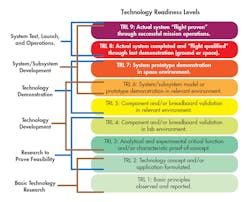Download this article as a .PDF
New tools, techniques, processes, and metrics are invented and tried out all the time. Some get great press out of the box because of the person or organization they are connected to. We hear about some of them and then a few years later we wonder where they went. Some have more quiet beginnings and disappear before we ever hear of them. About 99% follow this course within seven years. One can find them in internet searches, but that doesn’t tell you if they are being used.
There are a few methodologies that rise from the myriads and stand the test of time. We all know about them Robert Cooper’s Stage-Gate, Donald Clausing’s Concurrent Engineering, John Hauser’s QFD, Genrich Altshuller’s TRIZ, and 3M’s Vitality Index for new products. Well, we should add another to the list: Technology Readiness Levels . It has finally made the club.
Technology Readiness Levels (TRLs): TRLs have fast tracked their way around the world across many industries in a mere 17 years. TRIZ was a bit slower due to cultural barriers, but TRL’s adoption speed rivals those of other club members.
Another kid on the block is Return on Innovation, which is also known as "ROInnovation." It originated from several sources in the mid-2000s. It hasn't quite made the club yet, but it’s close. ROInnovation is an evolution of several ideas and a consistent approach to it has yet to settle-out in industry. This is quite the contrary for TRLs. Developed by the U.S. Department of Defense in the years surrounding the millennium, this fairly precise and logical technique was published as policy in the draft 2002 Defense Acquisition Guidebook.
TRLs got great press because a number of companies had to use them to report progress and needed to achieve various TRL levels to receive payment. So TRLs hit the ground running. NASA and other agencies loved them. The test of TRLs would be if they moved outside that sphere.
Many global defense companies, GE, Rolls-Royce, United Technologies, Boeing, and others have a good chunk of their business outside that sphere. Quickly after the technique was adopted it spread to the commercial side of the business. It was subsequently applied to company supply chains, and so rolled out. In the course of my travels, I caught wind of it at Tata in India, Bombardier in Canada, Embraer in Brazil, and the prestigious ITRI in Taiwan—all within a few years.
More recent travels came across it being used as a technology-rating instrument by the European Commission, and as a tool used by some European VC funds to determine investment portfolio appropriateness and/or the resultant level and duration of funding. These latest uses made it a member of the club.
Manufacturing Readiness Levels: TRLs come with an added benefit—they have associated “MRLs” that work with TRLs to monitor both product and process readiness. Most organizations that use TRLs also use MRLs at some level. Success breeds propagation.
In the years thereafter, Interface Readiness Levels (IRLs), System Readiness Levels (SRLs), and People Readiness Levels (PRLs) were created. Thankfully propagation stopped, but it had the benefit of fully underpinning the technique. Like QFD’s focus on nailing customer requirements at the start of the method, which remains a business priority 30 years later, we come to use the best part of the XRL family—the initial TRLs and MRLs.
The TRL Ecosystem: TRLs follow a logical, progressive 10-step process. At step 10, you sip the champagne. Information on the details of TRLs is plentiful, with articles and images abounding from every major continent. Most TRL descriptions do not adequately address intellectual property, a touchy subject with governments. Be sure to give your TRL and MRL levels a good look, and then plan your offensive and defensive intellectual property strategies accordingly. This is important regardless of whether you are a big company or a small maker looking for funding. In the latter case, the DARPA Hard Test for Innovation may also be of interest (a subject for another day).


